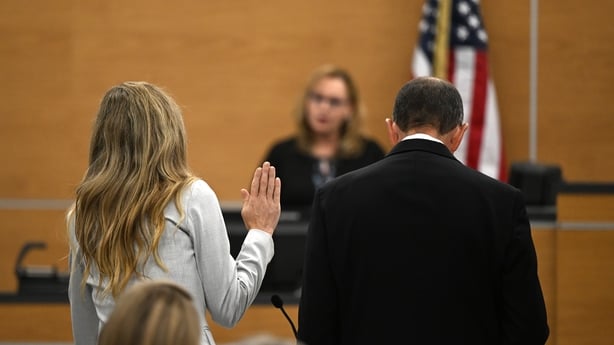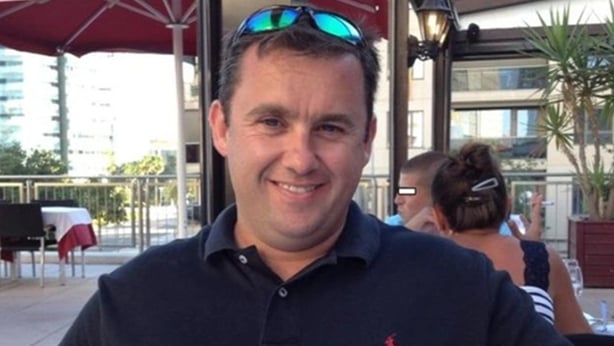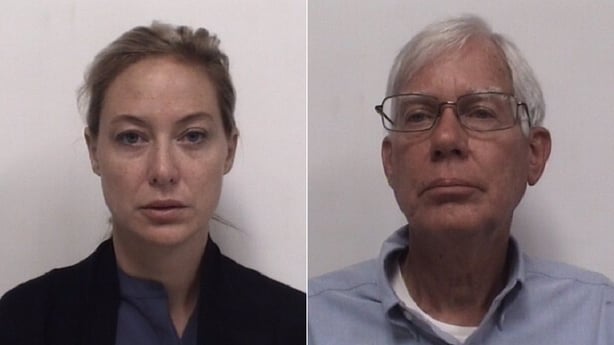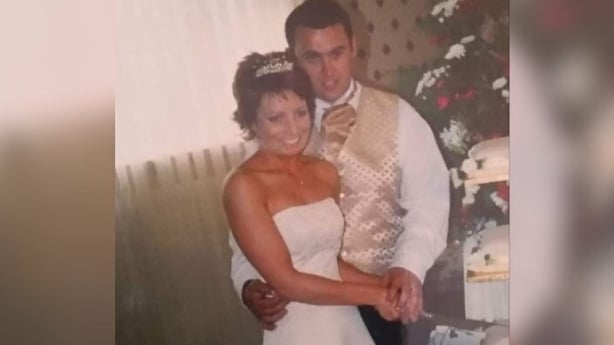Tom Martens came back into court number six whistling a tune, his hands in his pockets.
It was Thursday afternoon and there was a break in proceedings after two dramatic pieces of evidence.
There was a real sense that something had shifted in the case, that a tipping point had been reached.
The court had been hearing claims and counter claims about Jason Corbett's character and particularly about how he was quick to anger and was having almost constant rows with his wife.
But on Thursday the court heard a secret recording, made by Molly Martens Corbett in the kitchen dining area of the family home on Shrove Tuesday 2015, six months before Mr Corbett’s killing.
For the first time the court heard the voice of the victim and his wife.
And his two children, 10-year-old Jack and eight-year-old Sarah.
Arguing, bickering, occasionally shouting - all four of them were involved.
There was no cursing, no violence; it was not a particularly out-of-the-ordinary family dispute.
But it was strong corroborating evidence for a lot of other evidence and statements heard by the court.
The Assistant District Attorney prosecuting the case, Alan Martin, strongly objected to the tape, saying it was manufactured evidence, that Martens Corbett had set up a scene and provoked her husband to get the audio evidence she wanted. But the genie was out of the bottle.
The tape in no way justifies the killing of Mr Corbett. It does not alter the evidence of the crime scene, or witness statements.
But it does not have to: its purpose is mitigation – helping the defence argue that the people who killed Mr Corbett - Tom and Molly - should be shown leniency when the judge comes to pass sentence on them.

Plea deal
The proceedings in Lexington County Superior Court are a sentencing hearing following a plea deal.
Tom Martens has pleaded guilty to the manslaughter of his son-in-law.
His daughter, Mr Corbett's wife, had pleaded no contest to the charge of manslaughter.
In the law of North Carolina, that is taken to be a guilty plea for the purposes of the plea agreement that both Tom and Molly signed in court on Monday morning.
That agreement states: "For purposes of adjudication of the plea, Thomas Martens admitted striking Jason on the head with a metal baseball bat, and Molly [Martens] Corbett admitted striking Jason either on the head or shoulder with a concrete landscaping brick.
"The autopsy established that the death of Jason Corbett was caused by the cumulative effect of blows with a blunt object consistent with the objects the defendants admit using.
"The autopsy and circumstances of the scene establish that at least some of the fatal blows inflicted were of a nature, number, and level of force that exceeded what could have been reasonably necessary in furtherance of perfect self-defence."
So they killed Mr Corbett. That is not in dispute. The purpose of the hearing is to decide the sentence they will face for their crime.
That will be decided by Davidson County Superior Court Judge David Hall at the end of the hearing, which is expected to be at the middle or end of next week.
But first he has to hear evidence and arguments from lawyers for both sides – the prosecutors from the District Attorney’s office, who are seeking prison time of six to nine years for the defendants; and Tom and Molly’s defence lawyers, who are trying to argue exceptional mitigating circumstances that could justify a sentence of supervised probation.
That is the range of sentencing available to the judge. His decision will fall somewhere on that range.
Tom and Molly have already spent more than three years in prison.

This is what Martens Corbett has agreed to in her plea deal: "Defendant agrees to tender a plea of no contest to Voluntary Manslaughter, a Class D felony, on the theory of imperfect self-defence or defence of another.
"Upon the Defendant's plea, the State concedes the Defendant actually believed that defensive force was necessary but contends that at some point during the encounter that belief became unreasonable, and the amount of force employed was excessive.
"For the purpose of this plea and sentencing, the state does not embrace any other legal theory, including any theory that includes premeditation or malice as an element of the offense.
"Defendant agrees to waive indictment and to proceed on a bill of information.
"She further agrees to waive a jury trial on the existence of the non-statutory aggravating factor that the defendant committed an offense and knew (or reasonably should have known) that a person under the age of 18 who was not involved with the commission of the offense was in a position to see or hear the offense.
"The defendant expressly does not stipulate to the existence of the aggravating factor, but rather, agrees only to the procedure as described herein where the court can determine whether or not it exists beyond a reasonable doubt, and if so, what weight to give it relative to any mitigating factors found by the court as provided in N.C. Gen. Stat. 15A-1340.16(a) and (a7)."
Tom Martens’ agreement is the same, except for the very first line, which states: "Defendant agrees to tender a plea of guilty to Voluntary Manslaughter, a class D felony, on the theory of imperfect self defence or defence of another".

Narrative agreement
The prosecution and defence have agreed a narrative of what happened in the early hours of 2 August 2015 in the master bedroom of 160 Panther Creek Court.
Part of it reads: "Thomas opened the door to Jason and Molly's bedroom and observed Jason, whose back was to Thomas, with his hands around Molly's throat.
"Thomas told Jason to let her go and Jason moved his position to behind Molly, continuing to choke her.
"Jason told Thomas that he would kill her and began dragging her down the hallway toward the bathroom.
"At that point, Thomas said 'I hit him' with the baseball bat. After the first strike, Thomas said that Jason began to rage. Thomas said that his memory of the incident was blurry, but that Molly was able to get away briefly.
"During the incident, Jason knocked Thomas to the ground, knocking off his glasses.
"At this point, Thomas lost control of the baseball bat and said that he feared for his life. He figured Molly had somehow distracted Jason because he was able to get back up and regain control of the bat. Once he got up, he began striking Jason again.
"Thomas said that he didn't remember how many times he struck Jason and did not know how Molly distracted Jason.
"Thomas suffered no apparent injuries as a result of this incident.
"Molly reported that she had been strangled. Deputies on the scene noted a lack of visible injuries to Molly and noted that she repeatedly rubbed her neck.
"Paramedics on the scene checked Molly for injury. They noted light redness on the side of her neck.
"Paramedics noted her vitals were normal and that Molly refused transport to the hospital for further evaluation.
"Both Molly and Thomas agreed to go to the Sheriffs Department to be interviewed.
"In her interview, Molly told Lt Thompson that Jason had become angry at her that night because he had been awakened from his sleep when one of the children, Sarah, had a bad dream.
"At some point, Jason began choking her. She said she screamed out, which apparently alarmed her father who was staying with her mother in the guestroom below.
"Her father came into the bedroom with a baseball bat and began hitting Jason with it.
"Jason got the bat from her father and attempted to hit him with it. Molly said she picked up a concrete paver that was on her nightstand and hit Jason with it."

Autopsy and crime scene evidence
In arguing for the upper part of the prison sentence range available in this case, prosecutors are relying on autopsy and crime scene evidence to make a case that the amount of force used by Martens and his daughter was far more than was necessary for self defence.
Tom and Molly agree that there was an excessive level of force used – hence the mentions of "imperfect self defence" - but say there were a range of mitigating factors the judge should take account of.
Much of the presentation of the case relies on written transcripts of witnesses from the original trial, or of interviews made by investigators, but there have been some "live" witnesses in the courtroom, one of whom was Dr Craig Nelson, the medical examiner who carried out the autopsy on Mr Corbett.
The judge, the lawyers and Dr Nelson huddled around the witness box to look at autopsy photographs - sparing the rest of the court from having to look at the grisly exhibits.
Both the Corbett children - 19-year-old Jack and 17-year-old Sarah - were in court listening as Dr Nelson recounted the post mortem examination procedure, including slicing and peeling back the scalp to reveal the skull, removing the top of the skull and removing the brain.
The agreed factual basis of the case makes it clear what caused the death of Mr Corbett.
"The autopsy documented multiple blunt force impact sites of the head, notably including two large, complex, branched, full-thickness scalp lacerations, as well as extensive skull fractures including a hinge fracture of the skull base," the report read.
"He had associated epidural, subdural, and subarachnoid hemorrhage as well as associated cerebral cortical contusions. Other injuries included a large contusion of his left hand and a few other scattered abrasions and contusions. Toxicological testing detected a blood alcohol level of 20 mg/dL (0.02%).
"Based on the autopsy findings and circumstances surrounding the death, as currently understood, the cause of death is listed as blunt force head trauma. The manner of death is classified as homicide."
The prosecution are also relying on interpretation of blood "spatter" patterns at the crime scene.
The paramedics who arrived at the Corbett's house thought they were going to a heart attack victim, but found themselves entering an exceptionally blood-soaked scene.
Analysis of where the blood sprayed and pooled around the room, including on the floor, walls and ceiling, and bloodstains on the clothing worn by Tom and Molly - and the evidence of Dr Nelson that there were at least 12 impacts on Mr Corbett's skull.
Prosecutors say this points to an attack that went far beyond the needs of self defence.
They are claiming the forensic evidence points to Tom Martens in particular continuing to rain blows on Mr Corbett's head with a baseball bat while he lay on the ground, probably unconscious.

Aggravating factor
The aggravating factor in the case is the presence of the Corbett children in the house on the night of Mr Corbett’s homicide.
Judge Hall has seen and heard evidence, including videotaped interviews with the children made days after the crime, and live testimony in court from two police officers present at the scene, that the children were in the house, were asleep upstairs, had to be woken and carried downstairs, and were told to close their eyes as they passed the door to the master bedroom.
The judge has to rule on whether, and to what extent, this meets the definition of an aggravating factor as set out in the plea agreement.
The defence lawyers in this case accepts their clients beat Mr Corbett to death, but are arguing that there were strong mitigating factors that they believe should lead to a sentence of low or no prison time.
Even if they fail utterly, the maximum sentence spoken of in the agreement is nine years in prison, less than half the 20 to 25 year terms imposed in 2017 in the original trial, when the charge was second degree murder.
In the plea agreement, the prosecution agreed to drop the murder charge in return for guilty pleas to manslaughter.
So the aim of the defence in this sentencing hearing is to present evidence and arguments that may lead to lighter sentences for their clients, the mitigating factors.
Their key argument is that Mr Corbett was an angry, controlling, abusive and sometimes violent partner in the Corbett's marriage.
And they claim he became increasingly so over the four years of the marriage, while the family lived in North Carolina.
To make this argument they have been relying on evidence from Tom and Molly’s videotaped statements to Davidson Country Sheriffs office, made within hours of the death of Mr Corbett and replayed in full to the court.
And of videotaped interviews of the Corbett children making allegations of having seen and heard verbal and physical abuse in the household, and of live testimony from five women, all friends and neighbours of Molly Martens Corbett and Mr Corbett.
Prosecutors say all of these statements corroborate each other, and point to a pattern of abuse in the marriage.

Videotaped interviews
The evidence of the children was excluded from the original murder trial, as were statements made shortly after they returned to Ireland in 2015 recanting those statements.
The exclusion of that evidence was the grounds for Tom and Molly’s successful appeal which led to the 2020 quashing of their murder sentences and the order for a retrial.
Judge Hall indicated that he found these interviews formed important evidence.
Further recanting statements were made by Jack and Sarah Corbett in 2021, in preparation for the re-trial (which is not happening now because of the plea deal: this is a sentencing hearing for defendants who have pleaded guilty to manslaughter).
Extracts from those 2021 statements were included in the plea agreement and read into the court record.
From Jack's interview with detectives March 2021: "Jason never got angry, and I never saw Jason and Molly argue or scream at each other.
"I never saw Jason hurt or hit Molly. I never saw any physical altercation between them.
"I was told exactly what to say at the Dragonfly House, and I was told that if I didn't say these things that I would be taken away.
"Molly said if you don't say that dad hit me, I'll never see you again. So I did what I was told.
"I was never scared when my dad was there."
From Sarah's interview with detectives March 2021: "I never saw Jason hurt or hit Molly
"I never saw any physical altercation between them. There was a lot of verbal arguing and yelling, but both of them raised their voices.
"I was told exactly what to say at the Dragonfly House, and was told that if I didn't say these things that I would be taken away."
The judge noted that he saw some indications in the original Dragonfly House interviews that the children may have been coached, or had absorbed adult language on the matter in some of the answers they gave.
But he said there was a bigger "goose and gander issue" with the recanting statements, given that any theories about opportunity for coaching or absorption of views from surroundings in the six days following the killing of Mr Corbett also applied to statements made months and years later in another country.
The defence lawyers also point to the live witness evidence of social worker Sheila Tyler, who interviewed Martens Corbett on 3 August, the day after the death of Mr Corbett.
Asked if she ever felt in danger from Mr Corbett, Molly claimed he "forced" her to have sex with him, during which he would put his hand over her mouth and nose causing her to pass out.
The behaviour was becoming more extreme over time and she feared that this is what had led to the death of Mr Corbett’s first wife and that the same fate would befall her.

In both cases Martens Corbett had expressed her view that Mr Corbett's first wife Margaret had not died from an asthma attack, as reported, but may have been a result of similar behaviour.
This was an assertion based on an autopsy report from Limerick which did not, in Dr Nicholls opinion, describe a death from asthma. Dr Nicholls made no claim of what caused Margaret Corbett's death, but strongly criticised the autopsy report.
From a defence point of view, this testimony helps to back up their claim that Martens Corbett was frightened of her husband and feared that he might choke her to death.
This they argue is mitigation for the extreme violence meted out to Mr Corbett, which was in excess of what was necessary for self defence.
But there has been no evidence presented that Martens Corbett told either of her parents of any physical assaults or threats of physical violence or dangerous sexual behaviour.
Further evidence, live witnesses and argument will be presented at the sentencing hearing when it resumes tomorrow.





